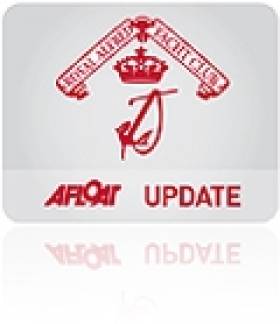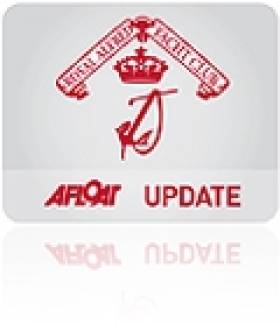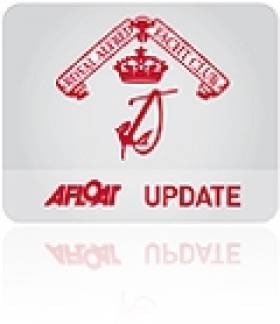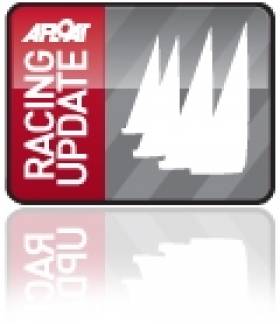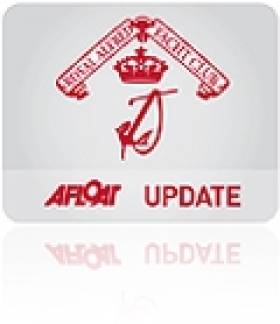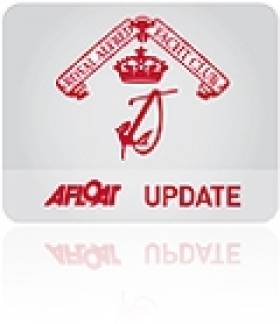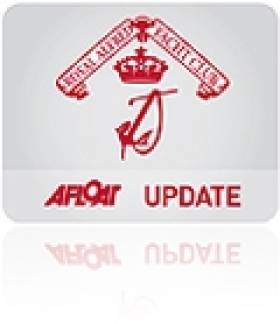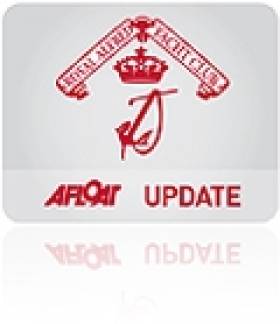Displaying items by tag: RAYC
Royal Alfred 2013 Superleague Starts This Weekend
The Royal Alfred Yacht Club 2013 Superleague comprises four Dublin Bay Saturday's (11th May, 27th July, 17th August and 14th September), Howth Regatta Lambay Race 8th June, RAYC Bloomsday Regatta 15th June and the Dun Laoghaire Regatta 11th to 14th July.
Club sailing secretary Eunice Kennedy reports the Royal Alfred will also stage its Baily Bowl one design event on the May 25 and 26th. The RAYC Bloomsday Regatta is on 15th of June.
Entries for our events can be done on line at www.rayc.ie.
Royal Alfred Yacht Club Meets Ahead of Busy Sailing Season
The Annual General Meeting of the Royal Albert Yacht Club will take place tomorrow, 12 April at 1900 in the Royal St George Yacht Club. All members are invited to attend to support their club.
The meeting will be an opportunity to discuss plans for 2013. A busy sailing season is planned with the Baily Bowl for one-design keelboats (25-26 May), the Bloomsday Regatta (15 June) and a four race Offshore/Coastal series, run in collaboration with the Irish Sea Offshore Racing Association, starting on 27 April, not forgetting the now traditional trips into the Liffey for racing in the centre of Dublin.
The RAYC Super League will this year include the HYC Lambay Race, the RAYC Bloomsday Regatta, the Dun Laoghire Regatta and 4 designated days racing with Dublin Bay Sailing Club. This series will run from June to September, providing a focus for crews as they plan their season.
Dublin Bay Boats Top Royal Alfred Yacht Club (RAYC) Superleague 2012
#rayc – There were Class One IRC wins for outgoing Dublin Bay Sailing Club (DBSC) Commodore Tony Fox in the The Royal Alfred Yacht Club Superleague this year and victory too for former Royal Irish Yacht Club (RIYC) Commodore Peter Redden in Class Zero IRC sailing Loose Change. The prizes will be presented at the RAYC Annual Black Tie Dinner in the National Yacht Club on Friday, 30th November, a highlight of the Dublin Bay sailing season.
The Superleague series for keelboats was revived in 2012. This series combines the results of the 5 Dun Laoghiare Regattas with 5 designated Dublin Bay Sailing Club race days. With 10 days racing in the series, with the 6 best counting for the final results, the SuperLeague has proved to be a successful and engaging addition to the Dublin Bay Sailing Club's programme of summer racing. Without adding to an already crowded sailing calendar, the RAYC Superleage provides a summer-long series, adding an 'extra frisson' of interest to racing in Dun Laoghaire.
The spread of ten races with a generous four discards meant that for this revived edition, almost 60 boats took part, a good percentage of the yachts that race on a regular basis. In most classes, winners winners were decided on the last or second last race of the series. However, "Supernova" was the clear leader from early on and never looked likely to give up their pole position.
The Royal Alfred Yacht Club has attached particular importance to awarding Superleague prizes not only the Skipper but also to the crew of winning yachts. These small mementoes are a reminder to us all that without the efforts of the crew there would be very little activity in the Bay !
The Royal Alfred Yacht Club Superleague will be sailed again in 2013. A special effort will be made to persuade those classes that did participate this year to join in this enjoyable extension to the racing programme.
Royal Alfred Superleague 2012 Results
Cruisers 0 IRC
1. Loose Change M.Mitton, P. Redden
2. WOW George Sisk
3. Tsunami Vincent Farrell
Cruisers 0 Echo
1. Tsunami Vincent Farrell
2. Loose Change M.Mitton, P. Reddan
3. WOW George Sisk
Cruisers 1 IRC
1. Gringo Tony Fox
2. Xtravagance Colin Byrne
3. Jalapeno P.Barrington, D. Baker et al
Cruisers 1 Echo
1. Jump the Gun M Monaghan, J. Kelly
2. Gringo Tony Fox
3. Powder Monkey Chris Moore, Mark Byrne et al
Cruisers 2 IRC
1. Smile P. O'Connell, E. Healy, B. O'Sullivan
Red Rhum Johnathan and Christopher Nicholson
Bendemeer Lindsay Casey, Denis Power
Cruisers 2 Echo
1. Bendemeer Lindsay Casey, Denis Power
2. Smile P. O'Connell, E. Healy, B. O'Sullivan
3. Peridot Jim McCann, Hugh O'Donnell et al
Cruisers 3 IRC
1. Supernova K. Lawless, P. Shannon, S. McCormack
2. Quest B. Cunningham, J. Skerrit
3. Asterix Counihan, Meredith and Bushell
Cruisers 3 Echo
1. Supernova K. Lawless, P. Shannon, S. McCormack
2. Quest B. Cunningham, J. Skerrit
3. Asterix Counihan, Meredith and Bushell
Beneteau 31.7
1. Prospect Chris Johnston
2. Attitude D. Owens, J. Sugars
3. Extreme Reality P. McSwiney, E. O'Rafferty
Ruffian 23
1.Paramour L. Power, D. Russell
2. Crescendo Loran Balfe
Shipman
1. Whiterock Henry Robinson
2. Gusto Christine Heath
White Sails IRC
1. Act Two M. O'Leary, T. Roche, D. Andrews
2. Vespucci S. & K. O'Regan
3. Calypso Howard Knott
White Sails Echo
1. Act Two M. O'Leary, T. Roche, D. Andrews
2. Vespucci S. & K. O'Regan
3. Calypso Howard Knott
The prizes will be presented at the RAYC Annual Black Tie Dinner in the National Yacht Club on Friday 30th November.
All members and friends of the RAYC are welcome and booking can be made directly with Mr Tim O'Brien, the Club Manager at 2805725.
More J109 Offshore Success as Jedi Lifts Royal Alfred YC Coastal Cup
#RAYC – It was only in the last race that Andrew Sarratt's Jedi from Dun Laoghaire moved from second to win the 2012 Royal Alfred Yacht Club (RAYC) Coastal Series run over three races in association with ISORA. Full results for the Dublin Bay based series are available for download below as an MS Word document.
It is another offshore win for the J109 class, a design that has proved unbeatable offshore this season.
The RAYC has awarded two trophies for the coastal series - one for the Gold fleet and another for the Silver fleet.
African Challenge, a Beneteau First 42, won the silver fleet.
The Royal Alfred Yacht Club Dinner and Prize-giving takes place on Friday 30th November in the National Yacht Club.
Racing Updates: RAYC Bloomsday, Mermaid, IRC Cowes, Wags, Lasers, Fireballs, Ruffians, Ailsa Craig
#regattas – After a week of rain and gales there was a full programme of yachting round the coast at the weekend with one of the biggest fleets racing for RAYC Bloomsday regatta honours at the National Yacht Club in Dun Laoghaire. From the same club the clinker Waterwags celebrated 125 years of racing on Dublin Bay with a 20–boat fleet and a Victorian high tea yesterday afternoon. There were celebrations too further up the east coast for K. Halliwell's 'She of the North' who won the fiftieth round Ailsa Craig race from the Royal Ulster Yacht Club.
Antrim sailor Chris Penney won the Laser Leinsters at Howth and in a possible sign of good things to come ISAF Youth Rep Finn Lynch of the National YC won the radial division. The Ruffian 23s raced for national honours on Dublin Bay and 20 Fireballs turned up to race for Ulster honours at East Down Yacht Club.
In Cowes, Royal Cork's Anthony O'Leary, who finished second last weekend in the 1720 Nationals on home waters, was second overall again yesterday in IRC one class at a windy British National Cruiser Championships. Great onboard action video from Cowes here.
And finally, if you are on the south coast this week and see a small half decked Mermaid dinghy take the time to say hello. She is currently in Crookhaven, West Cork heading east so expect to see her in Cork harbour this week or next! The clinker built Thumbalina is cruising round the coast from Foynes on the Shannon Estuary to Skerries in North Dublin as part of the eightieth celebrations of the traditional Dublin Bay class.
#bloomsday – Twenty sailing classes and 118 entries took to Dublin Bay to race for the Royal Alfred's (RAYC) historic trophies for this year's Bloomsday regatta writes Ailbe Millerick. The weather forecast was mixed and yielded 10-15 knots of breeze during the first race on the windward leeward courses laid ably by Hal Bleakley, Gordon Davies and Commodore Barry MacNeaney and their teams.
The wind strengthened considerably in the rains squalls that traversed the race courses and the second race witnessed a number of broaches down the runs as the breeze piped up to over twenty gusting twenty eight knots. Most class winners didn't quite go to form with notable exceptions.
The regatta was both challenging for the competitors and rewarding for those that survived the demanding weather conditions. Wind Guru was forecasting 14 to 16 knot westerlies gusting 18 knots at times. Met Eireann was predicting force 5 to 7 with the stronger winds in the afternoon - and boy, were they right! Hal Bleakley, PRO on Course A for Cruisers 0, 1, 2 and White Sails set windward leeward courses that called for different skills than those that the Helms are used to when racing around the Dublin Bay Marks.
The frequent rain squalls reduced visibility to less than 100 metres at times.
For the second race Hal increased the number of rounds and in a yachtmans' gale boats and crew were tested. Certainly the stories in the bar afterwards were not the usual exaggerations, but accurate retelling of the conditions endured.
Barry MacNeaney, PRO on Course B for Dragons, Shipmans, Cruiser 3, Benateau 21 and Glens set a long course for the first race that saw some classes barely finishing within the time limit, as despite the 20 knot plus wind a very strong ebb tide made the beat back to the finish an uphill struggle. With the wind increasing he shortened the course for the second race. There were some exciting downwind broaches with "Quest" practically putting her mast in the water on the downwind leg of the first round. Obviously not learning from her experience the spinnaker was again hauled up on the downwind leg of the second round, resulting in an even more spectacular broach that followed an hypnotic rolling that started as a slight swing of the mast but increased till the yacht was going through 60 degrees side to side and the inevitable happened. It is to the crew's credit that within a matter of seconds the boat was back on course and racing hard again.
Brian O'Hare won the Squibs and Denis Bergin upset Edinburgh Cup holder Martin Byrne in the Dragons. Great celebrations were had on veteran Liam Shanahan's Emir Herr beating Philip Dilworth's Orna steered by Brian Mathews who took the IRC handicap.
The ladies were to the fore with Anne Kirwan winning the Ruffians and Christine Heath's well reefed Shipman winning the tie break with Viking while her sisters Mary and Angela were runners up in the Squib Class. Overall it was a good days yachting after an awful week of rain and gales.
All Classes finished comfortably within the time limits and were no doubt glad to head for the shelter of the Harbour.
Gordon Davies was the PRO for the dingy classes and he set some excellent courses that gave the competitors ample opportunity to display their heavy weather skills. A comment of thanks from Ronan Beirne of the Flying Fifteen class said it was one of the best day's sailing they had enjoyed this year year and was of Championship standard.
The Alfred would like to thank all the volunteers who made Bloomsday a success, the Dun Laoghaire waterfront clubs and Dublin Bay SC.
Results:
CR0 IRC & Echo
Loose Change Pete Redden & Morris Mitton 5718 RIYC 1.00 2.00 1 3.00
Lively Lady Derek Martin 1644 RIYC 4.00 1.00 2 5.00
Tsunami Vincent Farrell 4007 NYC 3.00 3.00 3 6.00
White Sails Echo
Emir Herr Liam Shanahan 1118 NYC 1.00 1.00 1 2.00
Orna Philip Dilworth 532 NYC 2.00 2.00 2 4.00
Aurora Ray Conway 7380 NYC 4.00 3.00 3 7.00
White Sails IRC
Orna Philip Dilworth 532 NYC 1.00 1.00 1 2.00
Act Two T. Roche et al 4250 RIYC 3.00 2.00 2 5.00
Calypso Howard Knott 5643 RStGYC 4.00 3.00 3 7.00
CR1 Echo
Adrenalin Joe McDonald et al 1348 NYC 1.00 1.00 1 2.00
Powder Monkey Byrne Moore et al 28898 NYC 3.00 2.00 2 5.00
Gringo Tony Fox 7778 NYC 4.00 4.00 3 8.00
CR1 IRC
Gringo Tony Fox 7778 NYC 2.00 1.00 1 3.00
Adrenalin Joe McDonald 1348 NYC 1.00 4.00 2 5.00
Xtravagance Colin Byrne 10034 RIYC 3.00 3.00 3 6.00
Cr2 Echo
Bendemeer L Casey & D Power 521 RStGYC 1.00 1.00 1 2.00
Smile O'Connell/Healy/O'Sullivan 25007 NYC 2.00 3.00 2 5.00
Kamikaze P.Nash 8223 RStGYC 6.00 2.00 3 8.00
Cr2 IRC
Smile O'Connell/Healy/O'Sullivan 25007 NYC 1.00 2.00 1 3.00
Bendemeer L Casey & D Power 521 RStGYC 3.00 1.00 2 4.00
Diane ll Andrew Claffey 7 RStGYC ( 3.00) 1.00 3.00 1.00 1 8.00 3.00 5.00
Sigma 33
White Mischief Timothy Goodbody 4633 RIYC 1.00 1.00 1 2.00
Gwili Two D.Clarke/P.Maguire 4534 RStGYC 2.00 2.00 2 4.00
Moonshine R.Moloney 4999 RStGYC 3.00 3.00 3 6.00
31.7
Magic D.O'Sullivan/D.Espey 2004 RIYC 1.00 3.00 1 4.00
Prospect Chris Johnston 1565 NYC 3.00 2.00 2 5.00
After U Michael Blaney 1310 RStGYC 2.00 4.00 3 6.00
Beneteau 21
Chinook Andrew Bradley 2121 RIYC 1.00 1.00 1 2.00
Syzrgy Rowan Fogarty 2111 RSGYC 2.00 3.00 2 5.00
CR3 Echo
Gung Ho G & S O'Shea 216 RIYC 2.00 1.00 1 3.00
Supernova Shannon, Lawless, McCormack 7500 RIYC 3.00 3.00 2 6.00
Quest Jonathan Skerritt 508 RIYC 1.00 6.00 3 7.00
CR3 IRC Supernova
Supernova Shannon, Lawless, McCormack 7500 RIYC 2.00 1.00 1 3.00
Quest Jonathan Skerritt 508 RIYC 1.00 4.00 2 5.00
Gung Ho G & S O'Shea 216 RIYC 3.00 2.00 3 5.00
Ruffians
Ruff N Ready Ann Kirwan et al 6014 NYC 2.00 2.00 1.00 ( 2.00) 2 7.00 2.00 5.00
Carrageen 8511 1.00 3.00 ( 6.00) 3.00 3 13.00 6.00 7.00
Peridot Jim McCann et al 5507 RIYC 4.00 4.00 3 8.00
Portsmouth Yardstick
Arthur Mehigan 1136 RSGYC
Hugh Sheehy 2015 RSGYC
R Tate 386 RSGYC
Glen
Pterodactyl R & D McCaffrey 12 RStGYC 1.00 1.00 1 2.00
Glendun Brian Denham et al 9 RStGYC 2.00 2.00 2 4.00
Glenshesk Liz Faulkner et al 1 RStGYC 3.00 5.00 3 8.00
Flying 15
The Big Bow Wow 3708 3.00 1.00 1 4.00
Deranged 3665 1.00 5.00 2 6.00
Kooigjug 3897 2.00 4.00 3 6.00
Dragons
Sir Ossis of the River Denis Bergin 161 RIYC 2.00 1.00 1 3.00
Jaguar Martin Byrne 201 RStGYC 1.00 2.00 2 3.00
Hy Brasil P O'Reilly 197 RSGYC 3.00 5.00 3 8.00
Shipman
Gusto Christine Heath 724 RStGYC 2.00 1.00 1 3.00
Viking Mason et al 409 RStGYC 1.00 2.00 2 3.00
Whiterock Henry Robinson 740 RIYC 3.00 3.00 3 6.00
Squibs
Nimble Brian O'Hare 38 1.00 1.00 1 2.00
Chillax A & M Heath 664 2.00 2.00 2 4.00
Perfection Jill Flemming 44 3.00 3.00 3 6.00
#BAILYBOWL – Dragons, Squibs and RS Elites lined up for the Royal Alfred Baily Bowl one design series at the Royal St. George at the weekend, the modest RS Elite fleet included the recently crowned Miss Northern Ireland Tiffany Brien.
Winds gusting up to 25 knots and a big rolling sea made for challenging conditions for the series on Saturday but winds on Sunday were so light the titles were settled on Saturday's scores.
By far the biggest fleet at this Royal Alfred Yacht Club Championship was the National Squib Class with 13 entries, 3 from the Royal North of Ireland Y.C., 2 from Wexford Harbour Boat and Tennis Club, 2 from the Royal Irish Yacht Club and the rest from the host club the Royal St. George Yacht Club.
Race One on Saturday took place in tumultuous seas (waves up to 3m high) despite the wind strength being about 12 kts. Racing Squibs in these conditions is difficult with many waves breaking over the bows, causing the boats to take water and killing the forward momentum. The windward leeward races were not tactical- but the were won by boat speed and boat handling.
Race One Results: 1st. 'Andromeda', Nigel and Paddy Barnwell RIYC.
2nd. 'Toy for the Boys', Peter Wallace and Kerry Boomer. RNIYC.
3rd. 'Halloween', Fred Campbell. RNIYC
Race two followed immediately afterwards with the seas remaining steep and confused, but the North Easterly wind dropping slightly.
Results: 1st. 'Halloween', Fred Campbell. RNIYC.
2nd. 'Toy for the Boys', Peter Wallace and Kerry Boomer.
3rd. 'Quickstep III', L. Mc.Carthy Nolan & Gordon Patterson.
Race three followed with similar wind and sea conditions.
Results: 1st. 'Perequin', Vincent Delany and Noel Colclough. DMYC.
2nd. 'Quickstep III' L. Mc.Carthy Nolan & Gordon Patterson. RNIYC
3rd. 'Halloween', Fred Campbell. RNIYC
Race four and five on Sunday were abandoned due to a flat calm, no wind and poor visibility.
The Dublin Bay boats achieved two out of three first places but they could not compare with the consistency of the Northern boats, so the final results were:
First 'Halloween', 3,1,3 placings. Sail No. 148.
2nd. 'Toy for the Boys' 2,2,5 placings. Sail No. 818.
3rd. 'Quickstep III' 5,3,2 placings. Sail No. 820.
Best of the rest was 'Andromeda' with 1,4,6 placings.
Best Wexford boat was 'Chubble', Michael Jones. The Wexford club is new to Squibs and they now have a fleet of 7 boats which normally sail above the road bridge in Wexford town in the South Eastern corner of Ireland.
Best all lady team: 'Chillax' sisters Angela Heath and McLoughlin who had the benefit of a double dolphin escort while they were waiting for the second race to start.
Royal Alfred Baily Bowl one design series 2012:
Dragons
1st Sir Ossis of the River Dennis Bergin, 2nd Kin Simon Brien, 3rd Aphrodite Micheal Doorly.
Elites
1st Momentary Laps, John Patterson, 2nd Kin Tiffany Brien, 3rd, Fullmarks Mark Brien.
Squibs
1st Halloween Fred Campbell, 2nd Toys For The Boys Peter Wallace, 3rd Quickstep III McCarthy Nolan and Patterson.
Thanks to Eunice Kennedy and Vincent Delany for assistance with this report
#RAYC – 50 boats entered the Royal Alfred Yacht Club Niobe Trophy, run in conjunction with the last day of the Howth YC Spring Warmer series on Saturday 28th April.
The RAYC Niobe Trophy has long been a feature of the racing calendar in Howth. This year, in a change of format, the Niobe Trophy was sailed in conjunction with the last day of the Howth Yacht Club Spring Warmer Series. In this way, boats had an extra reason to compete on the closing day of the series.
Traditionally both the Niobe Trophy and the Spring Warmer series were events for one-design keel boats. This year they were also open to the Cruiser Classes.
The blustery north easterlies, with associated lumpy seas and cold rain, made for exciting conditions. All classes sailed two races. In keeping with objective of providing additional motivation for crews winning the Spring Warmer series winning boats did not guarantee victory in the Niobe Trophy.
At the prize-giving, RAYC Rear Commodore Joe Carton thanked the owners and crew for ensuring the success of this new formula, which will be repeated next year.
The Royal Alfred Yacht Club will be providing more racing for boats from Howth this year. The revived Royal Alfred Superleague will be open to boats from Howth, with a special welcome this year for the Puppeteers.
|
Boat Name |
Crew Details: |
|
|
Class 1 |
Equinox |
Ross McDonald |
|
Class 2 |
Sunburn |
Ian Byrne |
|
Class 3 |
Starlet |
Bourke/others |
|
Etchells |
Kootamundra Fetching |
Dan O’Grady Stephen Quinn / Des O’Flaherty |
|
SB3’s |
Sharkbait Dinghy Supplies TBC |
Ben Duncan / Moran Shane Murphy Ronan Downing |
|
Puppeteers |
Trick or Treat Harlequin |
Alan Pearson Dave Clarke / Liam Egan |
|
J24 |
James Encore Hard to Port Kilcullen Euro Car Parks |
J.P. Caldin Flor O’Driscoll HYC Team 25 |
|
Squib |
Kerfuffle |
Jonathan Craig / Hazel Ruane |
Late Entries Accepted for Bloomsday Regatta
Late entries are still being accepted for the Royal Alfred Yacht Club's Bloomsday Regatta on Saturday 18 June.
Racing for all cruiser and dinghy classes is set to begin at 1pm tomorrow in Dun Laoghaire.
Today is the closing date for postal entries, but late entries will still be accepted (incurring an additional late fee of €10).
To enter online without delay visit the RAYC website at www.rayc.ie.
Royal Alfred Yacht Club Give Notice of 153rd AGM
One of Ireland's oldest sailing institutions, the Royal Alfred Yacht ClubYacht Club, will hold its 153rd AGM on Dun Laoghaire's waterfront at the Royal St. George Yacht Club on Friday 15th April 2011 at 700pm.
For generations the RAYC has been an umbrella organisation, linking yacht racers from the rival harbours of Dun Laoghaire and Howth. It provides an attractive programme of regattas, complementing more local and national events.
The agenda for the meeting is:
1. Apologies
2. In memory of past members
3. Minutes of previous AGM
4. Report from the Commodore
5. Election of Flag Officers
6. Election of Committee Members
7. Finance Report
8. Election of Honorary Auditor
9. Any other business



























